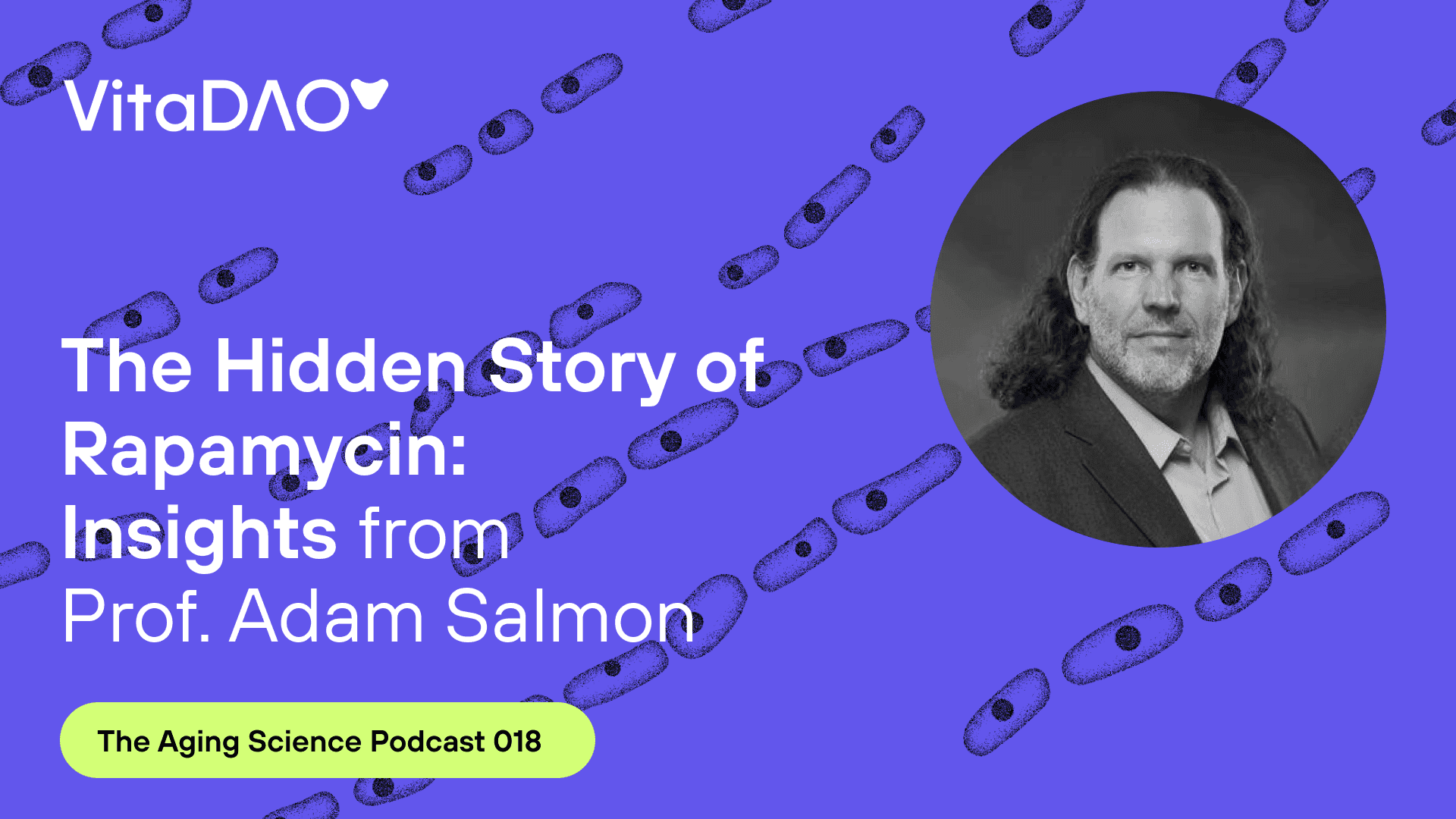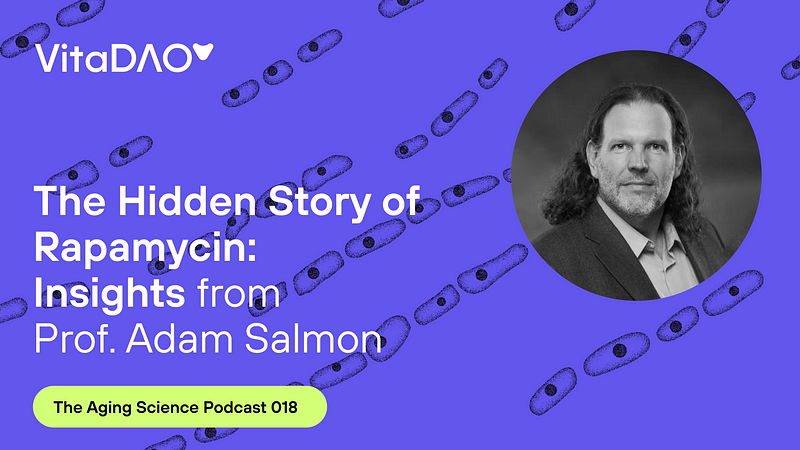
The Hidden Story of Rapamycin: Insights from Prof. Adam Salmon — The VitaDAO Aging Science Podcast


Meet the man who secretly ran the most important rapamycin study you never heard of. In this episode of the Aging Science Podcast I interviewed Prof. Adam Salmon. We talked about AMPK, caloric restriction (CR) mimetics and multistress resistance in aging. We also talked about the promise and disappointment with invertebrate models of aging. In the last part of the podcast we discussed the preliminary findings of a marmoset study that is testing whether rapamycin can extend the lifespan of a primate. This is definitely one of the most important ongoing studies in biogerontology. Check out the podcast to learn more.
Short Bio — Prof. Adam Salmon
Adam is a Professor with Tenure in the Barshop Institute and Department of Molecular Medicine at University of Texas Health San Antonio (UTHSA) with a joint appointment as Research Health Scientist in the Southwest Texas Veterans Health Care System. He is also a deputy director for the Interventions Testing Program.
The overall theme of his laboratory’s research concerns mechanisms of the basic biology of aging, with specific foci on metabolism and aging including mTOR, oxidative stress, and dietary interventions. His lab uses dietary, pharmaceutical, and genetic approaches in mammalian systems to address these questions.
Twitter: @uthealthBarshop
Will the real aging theory please stand up
We discuss the classic “anti-anabolic” interventions like caloric restriction (CR), protein restriction, methionine restriction and rapamycin. Are these CR-mimetics or not? Then we also talk about the AMPK pathway that is involved in sensing of energy stress. Adam was involved in studies of beta-guanidinopropionic acid, which is an AMPK activator that acts by reducing creatine transport into the cell. We discuss whether this is really desirable or not and the importance of transient activation.
While CR is known for improving glucose homeostasis, rapamycin does not consistently improve glucose homeostasis. Adam believes that protein restriction is much closer to CR than rapamycin.
Adam points out that slowing aging and improving age-related phenotypes is not the same. One can imagine that creatine might improve frailty without affecting aging, for example. Whereas the AMPK activator beta-guanidinopropionic acid could slow aging without improving frailty.
Are invertebrates a good model of aging?
We discuss a recent theoretical paper by Bene and Salmon (2023) that asks whether you can translate invertebrate lifespan results to mice. Yes, you can but it is complicated as it turns out. Adam points out that almost everything seems to extend invertebrate lifespan. Compounds are likely to work in both mice and invertebrates. Unfortunately, failures in invertebrates do not predict failure in mice. Thus it remains an open question whether
We both point out lack of rigor as a complicating factor. Many studies suffer from problems: small sample size, unhealthy and short-lived control animals, We discuss the ITP and the CITP as a potential solution.
Another issue that we discuss is publication bias which could explain why so many lifespan studies are positive. No one gets rewarded for publishing a negative study. This is an issue in biogerontology and every other medical field.
We also discuss whether it is too early to study the translation of compounds from invertebrates to mice. I point out that we have been running lifespan studies for over 40 years and Adam adds that the ITP itself existed for some 20 years. It is time.
Interestingly, even rapamycin does not work in all models.
“in some ways its kind of luck the first time a compound works, you got the right dose, started at the right period of life” (Adam Salmon)
Marmosets ARE a good model of aging
These primates are much longer lived than rodents at an average lifespan of 8–10 years yet not much larger than rats. They die of a much wider range of disease than mice do. Also in contrast to mice they do not constantly graze and are hence less likely to get obese.
Some 10 years ago Adam and colleagues started a study in marmosets to test whether rapamycin will extend their lifespan. The study randomized 66 marmosets and is powered to detect a lifespan difference of 10 to 15%.
Some people have asked why the study uses such a high dose of rapamycin and in response Adam points out that the study was designed before low dose and intermittent rapamycin regimes existed. This explains a lot. As for the choice of animal model? He decided to use marmosets instead of other primates because he could partner with other researchers who already had a large marmoset colony. Setting up a colony by yourself would be prohibitive.
Either way, there is no perfect small primate model. Rhesus monkeys are well studied but too long-lived and expensive. Now this knowledge gap is closing as more people turn towards small primate models like marmosets or mouse lemurs.
No evidence of immunosuppression, lipid and glucose abnormalities even though mTOR signaling was clearly suppressed in these primates. Kidney disease was improved but not epigenetic aging (Horvath et al. 2021) judged by a marmoset clock co-developed with Steve Horvath.
If rapamycin works in marmosets this would be groundbreaking. Check out the podcast for more details and discussion of survival data!
Further reading and references
Bene, Michael, and Adam B. Salmon. “Testing the evidence that lifespan-extending compound interventions are conserved across laboratory animal model species.” GeroScience 45.3 (2023): 1401–1409.
Pubpeer comments:
https://pubpeer.com/publications/C8B62FEDFC7F3D947D72E184E42EDD?utm_source=Chrome&utm_medium=BrowserExtension&utm_campaign=Chrome
Horvath, Steve, et al. “DNA methylation age analysis of rapamycin in common marmosets.” GeroScience 43 (2021): 2413–2425.
https://link.springer.com/article/10.1007/s11357-021-00438-7


